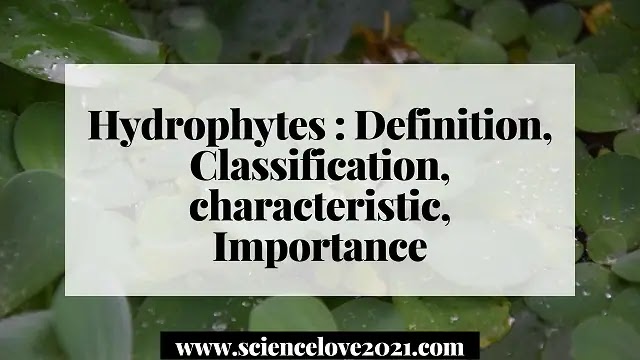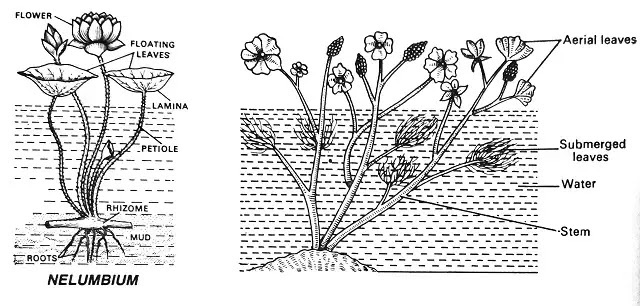Define Hydrophytes

Hydrophyte Plants are growing in water or near water. Some common Hydrophytes are Hydrilla, Eichhorina, Typha, pistia, and Trapa. these plants are completely submerged in water or some of their parts like roots, rhizomes, etc. remain in contact with water. Aquatic plants have many such characteristics or adaptations due to which they can live in water. These features are as follows-
Characteristic of Hydrophytes
1. Their tissues have sponginess due to water accommodation and optimum aeration of the tissue. All hydrophytes in the transverse section show the presence of large intercellular spaces or cavities developed in all parts of the plant which are filled with air.2. The root system is poorly developed, usually shorter and much less branched than the average plant, in some floating hydrophytes, e.g., Wolffia, Salvinia, etc., the roots may be entirely absent.
3. The epidermis usually lacks a cuticle or periderm (suberised cork cells) and stomata are generally absent in the submerged organs if present, they function less. Tile lack of cuticles, from the cell walls of submerged organs, makes the organs capable of absorbing water and nutrients throughout their surface directly rather than using root absorption.
4. Mechanical tissue though very feebly developed is amply compensated by the buoyancy due to the presence of parenchyma and the support afforded by surrounding water renders the formation of mechanical tissue seemingly unnecessary.
5. Conducting tissue is poorly developed. Vascular tissue is usually found towards the center of the stele with very few bundles towards the periphery for the pulling forces exerted in quickly flowing water are more economically met by aggregation of vascular bundles towards the center.
6. The almost complete absence of secondary growth in the thickness of stems and roots of hydrophytes.
Classification of Hydrophytes
Hydrophytes are divided into 3 groups given below:
- Submerged Hydrophytes
- Floating Hydrophytes
- Amphibious Hydrophytes
1. Submerged Hydrophytes
They grow entirely underwater. Rooted in mud to the bottom and absorb water, minerals, and gases through direct diffusion from their entire body surface. They usually possess a poor root system for absorption. Their leaves and stems both are meant for assimilation and absorption. For example Hydrilla, Potamogeton, Vallisneria. (All monocot) Cemtophyllum, Utricularia, Spiraiis. (All dicot)
Morphological characters of submerged plants-
Morphological characters of submerged plants-
1. The plant body is usually thin and delicate.
2. They are usually yellowish-green in color.
3. The plants are mostly rootless example Cerazophyllum, and Utricularia etc. if the roots are present they are poorly developed, for example, Hydrila, Vallisneria Spirallis, etc.
4. Leaves are very thin and membranous.
5. The stem is slender and may remain covered with mucilage.
6. The plants are spongy.
7. Vegetative reproduction is very common in hydrophytes. This is done by fragmentation.
8. The root cap is absent but the root pocket may be present.
Anatomical characteristics of submerged plants-
2. They are usually yellowish-green in color.
3. The plants are mostly rootless example Cerazophyllum, and Utricularia etc. if the roots are present they are poorly developed, for example, Hydrila, Vallisneria Spirallis, etc.
4. Leaves are very thin and membranous.
5. The stem is slender and may remain covered with mucilage.
6. The plants are spongy.
7. Vegetative reproduction is very common in hydrophytes. This is done by fragmentation.
8. The root cap is absent but the root pocket may be present.
1. There remain present big intercellular spaces.
2. Cuticle absent or poorly developed.
3. Normally epidermal cells possess chloroplasts.
4. In these stomata are absent but if present it is non-functional.
5. Mesophyll tissue undifferentiated into palisade and spongy tissues.
6. Mechanical tissues (like sclerenchyma) are absent or extremely reduced.
7. Vascular tissue (xylem, phloem) is very much reduced.
8. There is no secondary growth.
9. The osmotic pressure of cells is low and hence wilt as soon as they are removed from water.
10. Presence of only thin-walled parenchyma.
Free-floating
(a) Free-floating - Some hydrophytes (e.g. Wolffia, Lemna, Spirodella, Azolla, and Eichhornia) float freely on the water surface. These plants remain in contact with water and air but not in contact with the soil.
2. Cuticle absent or poorly developed.
3. Normally epidermal cells possess chloroplasts.
4. In these stomata are absent but if present it is non-functional.
5. Mesophyll tissue undifferentiated into palisade and spongy tissues.
6. Mechanical tissues (like sclerenchyma) are absent or extremely reduced.
7. Vascular tissue (xylem, phloem) is very much reduced.
8. There is no secondary growth.
9. The osmotic pressure of cells is low and hence wilt as soon as they are removed from water.
10. Presence of only thin-walled parenchyma.
2. Floating Hydrophytes
Those Plants who floats on surfers of water are called Floating Hydrophytes. They are of two types:Free-floating
(a) Free-floating - Some hydrophytes (e.g. Wolffia, Lemna, Spirodella, Azolla, and Eichhornia) float freely on the water surface. These plants remain in contact with water and air but not in contact with the soil.
 |
| Free Floating Hydrophytes |
Characteristic of free-floating plants-
- Morphological
- Anatomical
- The plants are minute in size.
- Roots are poorly developed or absent. Roots if present are devoid of root hairs.
- No root cap but root pockets may be present.
- Petiole is pulvinus and spongy.
- They are Deep green in color.
(ii) Anatomical
- Presence of air cavities and air chambers.
- Presence of stomata on the upper surface of the epidermis.
- In leaves the mesophyll may be differentiated into palisade and spongy tissue.
- Mechanical tissues like selerenchyma, and collenchyma are absent in these plants.
- There is no secondary growth.
- Trichosclereids are present e.g., Eichhormia.
(b) Fixed floating plant - These plants have rhizomatous stems and produce long petiolated leaves that float over the surface of the water (Nelumbo nucifera, Nymphaea, Nympha (water lily) stellata, Nelumbium speciosum). Their leaves have stomata on the upper surface only (epistomatic). They remain in contact with soil, water, and air.
The chief characteristic features of the plants are -
- The roots are well developed and remain attached in mud.
- The stem is an underground rhizome.
- The leaves are large and float on the surface of water.
- The petiole is long and spongy.
- The upper surface of the leaf usually remains covered by a waxy coating example Nymphaea.
- Stomata remain present on the upper surface of the leaf.
- In leaves the mesophyll is well differentiated into palisade and Spongy tissues.
- There is no secondary growth present in these plants.
- Air spaces are much developed.
- In Jussiaea the fleshy roots are present.
- The mechanical tissue is normally absent, if present they poorly developed.
3. Amphibious Plants (Emergent anchored hydrophytes)
These plants grow in shallow water and extend their shoots well above the surface. Their roots, parts of the stem, and often a portion of leaves are underwater but a portion and often most of the shoot is aerial. Actually, these plants are well adapted for aerial as well as for aquatic life. The common examples of amphibious plants are Typha, Ranunculus Eloeocharis, aquatilis, etc.
Characteristic features of the plants are -
- The roots are well-developed.
- The leaves have thin cuticles.
- Stomata are present on both sides of the leaves.
- The leaves have well-differentiated palisade and spongy parenchyma.
- The vascular tissue is quite well developed.
- The endoderm is thick.
- The mechanical tissue may remain present.
- The air spaces are less developed.
- Plants are usually erect and leaves are variously modified.




No comments:
Post a Comment